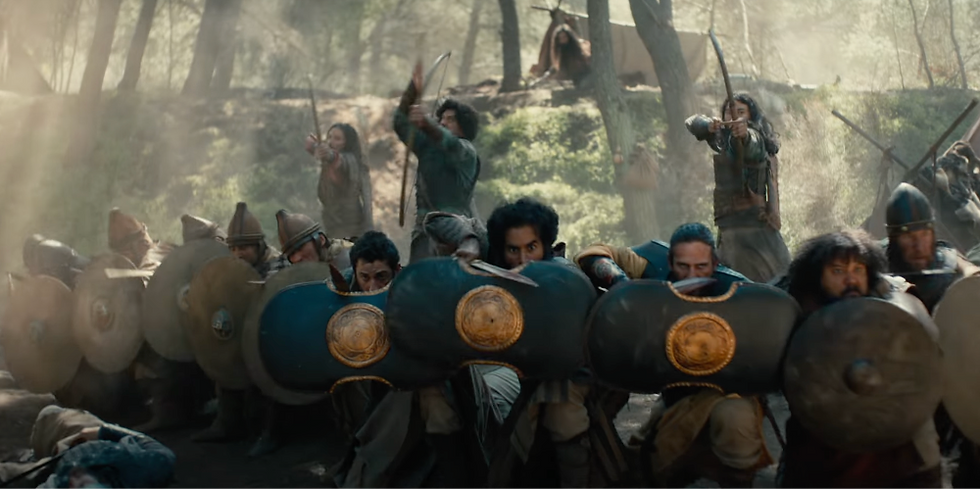Read Like An Artist: Setting & Context
- Kevin Keating

- Jul 29, 2019
- 5 min read
Context is a popular topic in biblical studies and preaching, as evidenced by the plethora of resources aimed at explaining the biblical world's culture, daily life, geography, warfare, and pretty much any other topic you could think of. It may seem odd then to suggest that Bible Artists have a unique concern for context that others lack. Even so, although many other readers do take interest in context and setting, Bible Artists approach and take interest in the biblical context with a unique perspective.
For Bible Artists context is not merely a stepping stool toward interpretative nuggets. Rather than explaining what a story means, they’re trying to recreate the world of the story so that their audience can experience it in a new way.
Many readers approach the biblical context as a kind of decoder key that will enable them to unlock unique and innovative interpretations of a particular story. This pattern of behavior is often learned from speakers or writers whose innovative interpretations allow them avoid uncomfortable readings, establish their own authority, and/or keep their audiences entertained. For those who follow this approach, context, although useful as a tool for interpretation, is not of interest in and of itself.

For Bible Artists context is not merely a stepping stool toward interpretative nuggets. Rather than explaining what a story means, they’re trying to recreate the world of the story so that their audience can experience it in a new way. Adaptations embody context. As a result, the process adaptation is all about imaginatively entering into the world of the story – not just the personalities and plot but also the concrete details of the setting and of everyday life – all so the Bible Artist can then bring that world into being through his or her chosen medium. To that end, the kinds of resources mentioned above are of great value.
Amplifying the Context
Of course, an adaptation is not a history book or a documentary. The point of exploring the concrete details of geography, warfare, and food isn't slavishly reproducing every detail for the sake of precision. The goal of the Bible Artist is to enter into the context of a story in order to perceive the feel of an event and to then to recreate that feeling in the audience. This requires sifting through the details of an event in order to determine which ones are necessary to create the proper effect. At times, it also means playing around with the historical details, leaving historical precision behind in order to achieve atmospheric accuracy.

Dunkirk is a useful movie for comparison. Although highly revered for its historical accuracy, the film also bends the precise details of what happened during the evacuation across the English Channel. Some of these changes may be errors, many of them are clearly intentional shifts intended to convey what the event actually would have felt like. For example, although the fleet of civilian vessels that aided in the evacuation may not have been quite as significant as it appears on screen, even so, to show how extraordinary and courageous it would have seemed, its role in the event was emphasized and the role of the actual British Navy was deemphasized. In instances like this, forsaking the precise details of the context allows the creator to more accurately capture the essence.
With this in mind, Bible Artists should research the context of narratives with the following questions in mind:
How would these historical details affect the way that the characters felt or experienced the events of the story?
Which historical details are critical to appreciate what these events would have felt like?
How committed should my adaptation be to historical precision?
Are there historical details that should be left out or even altered in order to make sure that the adaptation recreates the right feeling or experience?
What details am I willing to change or leave out for the sake of convenience or other secondary concerns?
Transforming the Context
At times, adaptations opt for an even more radical transformation of the context, completely shifting the story into another time and culture. While such efforts don't always work out well, the general impulse emanates from a similar motivation. Imaginatively entering into the biblical world can be difficult for some audiences, particularly for those that have less familiarity with ancient history. The significance of cultural practices and artifacts can be easily lost, and an adaptation may not have the time it needs to both educate its audience and tell its story. At times then, the Bible Artist enters into the original context on behalf of his audience and then, instead of recreating a stylized version of that context, finds an appropriate analog that will be more familiar and relatable. If carefully chosen, this analog setting can then have the most significant details of the original culture mapped onto it, creating a context with a similar feel, even if it is quite distant chronologically and geographically.
The effectiveness of these contextual transformations can be seen in how often such films are used in classrooms as a tool to help students gradually enter into the context fo the original story.
Shakespeare films are perhaps best known for taking this approach to adaptation. Because of how the culture and setting of Shakespeare's plays is viewed as too distant and remote for the average audience member to appreciate the significance of, his works have been transported into a variety of analogous contemporary settings including high school, organized crime, and the corporate world. The effectiveness of these contextual transformations can be seen in how often such films are used in classrooms as a tool to help students gradually enter into the context fo the original story.

Bible Artists hoping to take this approach should be careful not to get too sloppy. Before choosing a setting to transport the story into, they should still research the original context and setting in depth and ask questions like:
How would these historical details affect the way that the characters felt or experienced the events of the story?
Which historical details are critical to appreciate what these events would have felt like?
What aspects of the culture and setting are unique and strange?
As they're researching the original culture, they'll naturally begin to have ideas about potential analog cultures. When evaluating how appropriate an analog is, it helps to ask:
What specific ways does this culture/time/location overlap with or parallel the culture and setting that I researched?
Are the key historical details of the original setting represented through these parallels? If not, are there ways that I could create a parallel in the analog culture that will be easy for my audience to follow?
What significant differences are there between the original setting and this new context? How will these differences affect the way that the audience experiences the story?
Is the analog culture familiar enough to the audience that it will help them understand the story and experience the context more fully?
And that's it for now on my #ReadLikeAnArtist series. I hope that some of the questions that I raised were helpful and that, even if you aren't into adaptation, they will provide you with another lens through which you can encounter biblical stories!













Comments